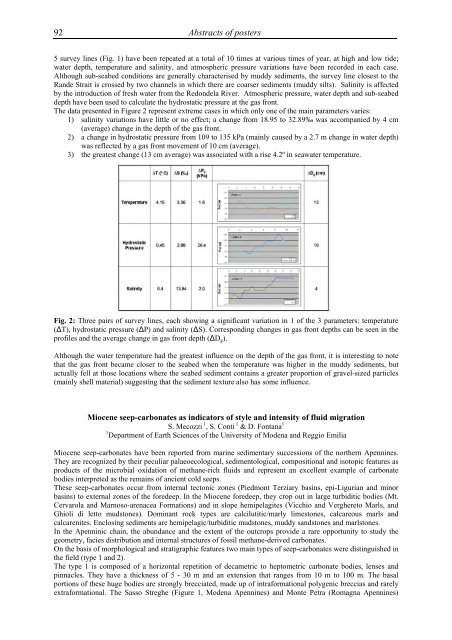Ninth international conference on - Marum
Ninth international conference on - Marum
Ninth international conference on - Marum
You also want an ePaper? Increase the reach of your titles
YUMPU automatically turns print PDFs into web optimized ePapers that Google loves.
92<br />
Abstracts of posters<br />
5 survey lines (Fig. 1) have been repeated at a total of 10 times at various times of year, at high and low tide;<br />
water depth, temperature and salinity, and atmospheric pressure variati<strong>on</strong>s have been recorded in each case.<br />
Although sub-seabed c<strong>on</strong>diti<strong>on</strong>s are generally characterised by muddy sediments, the survey line closest to the<br />
Rande Strait is crossed by two channels in which there are coarser sediments (muddy silts). Salinity is affected<br />
by the introducti<strong>on</strong> of fresh water from the Red<strong>on</strong>dela River. Atmospheric pressure, water depth and sub-seabed<br />
depth have been used to calculate the hydrostatic pressure at the gas fr<strong>on</strong>t.<br />
The data presented in Figure 2 represent extreme cases in which <strong>on</strong>ly <strong>on</strong>e of the main parameters varies:<br />
1) salinity variati<strong>on</strong>s have little or no effect; a change from 18.95 to 32.89‰ was accompanied by 4 cm<br />
(average) change in the depth of the gas fr<strong>on</strong>t.<br />
2) a change in hydrostatic pressure from 109 to 135 kPa (mainly caused by a 2.7 m change in water depth)<br />
was reflected by a gas fr<strong>on</strong>t movement of 10 cm (average).<br />
3) the greatest change (13 cm average) was associated with a rise 4.2º in seawater temperature.<br />
Fig. 2: Three pairs of survey lines, each showing a significant variati<strong>on</strong> in 1 of the 3 parameters: temperature<br />
(∆T), hydrostatic pressure (∆P) and salinity (∆S). Corresp<strong>on</strong>ding changes in gas fr<strong>on</strong>t depths can be seen in the<br />
profiles and the average change in gas fr<strong>on</strong>t depth (∆Dg).<br />
Although the water temperature had the greatest influence <strong>on</strong> the depth of the gas fr<strong>on</strong>t, it is interesting to note<br />
that the gas fr<strong>on</strong>t became closer to the seabed when the temperature was higher in the muddy sediments, but<br />
actually fell at those locati<strong>on</strong>s where the seabed sediment c<strong>on</strong>tains a greater proporti<strong>on</strong> of gravel-sized particles<br />
(mainly shell material) suggesting that the sediment texture also has some influence.<br />
Miocene seep-carb<strong>on</strong>ates as indicators of style and intensity of fluid migrati<strong>on</strong><br />
S. Mecozzi 1 , S. C<strong>on</strong>ti 1 & D. F<strong>on</strong>tana 1<br />
1 Department of Earth Sciences of the University of Modena and Reggio Emilia<br />
Miocene seep-carb<strong>on</strong>ates have been reported from marine sedimentary successi<strong>on</strong>s of the northern Apennines.<br />
They are recognized by their peculiar palaeoecological, sedimentological, compositi<strong>on</strong>al and isotopic features as<br />
products of the microbial oxidati<strong>on</strong> of methane-rich fluids and represent an excellent example of carb<strong>on</strong>ate<br />
bodies interpreted as the remains of ancient cold seeps.<br />
These seep-carb<strong>on</strong>ates occur from internal tect<strong>on</strong>ic z<strong>on</strong>es (Piedm<strong>on</strong>t Terziary basins, epi-Ligurian and minor<br />
basins) to external z<strong>on</strong>es of the foredeep. In the Miocene foredeep, they crop out in large turbiditic bodies (Mt.<br />
Cervarola and Marnoso-arenacea Formati<strong>on</strong>s) and in slope hemipelagites (Vicchio and Verghereto Marls, and<br />
Ghioli di letto mudst<strong>on</strong>es). Dominant rock types are calcilutitic/marly limest<strong>on</strong>es, calcareous marls and<br />
calcarenites. Enclosing sediments are hemipelagic/turbiditic mudst<strong>on</strong>es, muddy sandst<strong>on</strong>es and marlst<strong>on</strong>es.<br />
In the Apenninic chain, the abundance and the extent of the outcrops provide a rare opportunity to study the<br />
geometry, facies distributi<strong>on</strong> and internal structures of fossil methane-derived carb<strong>on</strong>ates.<br />
On the basis of morphological and stratigraphic features two main types of seep-carb<strong>on</strong>ates were distinguished in<br />
the field (type 1 and 2).<br />
The type 1 is composed of a horiz<strong>on</strong>tal repetiti<strong>on</strong> of decametric to heptometric carb<strong>on</strong>ate bodies, lenses and<br />
pinnacles. They have a thickness of 5 - 30 m and an extensi<strong>on</strong> that ranges from 10 m to 100 m. The basal<br />
porti<strong>on</strong>s of these huge bodies are str<strong>on</strong>gly brecciated, made up of intraformati<strong>on</strong>al polygenic breccias and rarely<br />
extraformati<strong>on</strong>al. The Sasso Streghe (Figure 1, Modena Apennines) and M<strong>on</strong>te Petra (Romagna Apennines)














